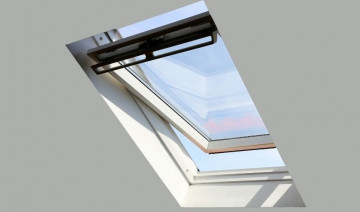
Skylight Red Flags
Two aspects of the job —framing the light well and flashing the unit — have the greatest potential for problems.
When it comes to retrofitting skylights, two aspects of the job - framing the light well and flashing the unit - have the greatest potential for problems. Framing is typically only a problem in trussed roofs, but, says veteran remodeler Les Deal of Cedar Rapids, Iowa, “All of the houses I'm working on have trusses.”
Truss Alert Most remodelers understand that cutting any chord can disrupt the balance of tension and compression resistance in a truss. Deal always runs any alterations by an engineer. Typically the change involves installing king posts supported by a bearing wall to create a half truss on one side of the roof, and sistering along the trusses on the other side, essentially converting it to a rafter roof system.
Code officials, however, always want some engineering. In many municipalities, Deal can simply consult with an engineer. The key here, he explains, is having a strong rapport with the code official. “I always tell the official what I'm up to well in advance, so there's no surprise when he comes out to inspect.” Often, Deal says they just want to know that an engineer has reviewed the structural design, without getting the plans stamped.
“The problem is that no truss engineer wants to talk about someone else's truss,” Deal explains. “They ask, ‘Is it our truss?' But in a house built 20 to 30 years ago, who's to say?” Deal often ends up paying a modest consulting fee to engineers he has worked with in the past. If the municipality requires an engineer to sign off on the plans, the fee would be much higher. “The job itself is straightforward. It's all the fuss the truss industry has created that makes altering a truss so problematic,” Deal says. “The alternative, however, is to avoid the hassle and just put in a small unit between trusses, but I think that looks stupid.” Deal believes that a light well that splays out in four directions looks so much better, in fact, he goes the extra mile to sell the client on the idea. “It's an upsell that works. It completely transforms a room when you can see the skylight from any angle, and customers are never disappointed,” he insists.
Know the Roof When evaluating a skylight job, remodeling contractor Mike Guertin, author of "Roofing with Asphalt Shingles" (The Taunton Press) and a frequent contributor to JLC, always begins by satisfying two key questions: First, is the roof one layer or two? If there are two roof layers, the job is much more involved. Flashing should adhere to the roof deck, so both roofs must be removed and then patched. Second, what is the condition of the roof? “If there's a leak after I've installed a skylight, it's always the skylight that caused it,” Guertin jests, but continues in a more serious vein: “If the roof is substandard, I back up and force the client to deal with the roof first.”
“If the roof is older than 10 years, or is in any need of repair, I shift my attention to this,” Deal says. “If they have the budget to do the roof now, I include this in the job. Otherwise, I advise taking care of the roof first, and doing the skylight later.”
By the Book Both Guertin and Deal always sell the client on the flashing kit made for a particular skylight. Typically, a skylight warranty only applies if it is installed with the manufacturer's flashing. “It doesn't matter how right it's done if it's not their right,” Deal says. “But if you follow the directions, most [manufacturers] are willing to help if there's a problem.”
